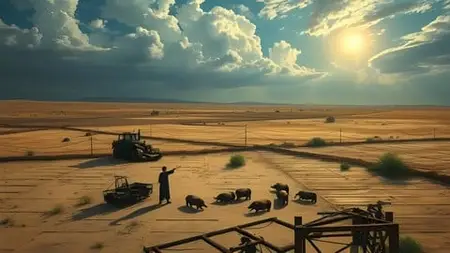Drought Risk Mapping Using Remote Sensing And Gee
Published 8/2025
MP4 | Video: h264, 1920x1080 | Audio: AAC, 44.1 KHz
Language: English | Size: 609.30 MB | Duration: 1h 4m
Published 8/2025
MP4 | Video: h264, 1920x1080 | Audio: AAC, 44.1 KHz
Language: English | Size: 609.30 MB | Duration: 1h 4m
Master the use of satellite remote sensing data and Google Earth Engine to analyze, map, and monitor drought risk
What you'll learn
Analyze drought risk factors using remote sensing data and understand their impact on agriculture.
Process, filter, and visualize multi-source satellite data effectively in Google Earth Engine.
Calculate, normalize, and interpret various drought risk indices using NDVI, rainfall, and soil moisture data.
Develop, export, and utilize detailed drought risk maps to support informed agricultural decision-making and resource management.
Requirements
No prior experience with Google Earth Engine is required — the course will guide you step-by-step.
Description
Drought poses a significant threat to global agriculture, impacting food security, water resources, and livelihoods. This course equips you with cutting-edge skills to analyze and map drought risk using remote sensing data and the Google Earth Engine platform. Beginning with the fundamentals of remote sensing, you’ll gain a solid understanding of how satellites like Sentinel-2 capture essential data on vegetation health and soil moisture.The course then delves into remote sensing applications for environmental risk mapping, with a special focus on drought. You will learn to process time-series satellite images, calculate vegetation indices such as NDVI, and assess rainfall and soil moisture anomalies by comparing current data with historical baselines.Next, you will be introduced to Google Earth Engine—a cloud-based platform that simplifies large-scale data analysis. You’ll get hands-on experience scripting in GEE to integrate multiple datasets and develop comprehensive drought risk indices. The course also covers normalization techniques and anomaly detection to identify areas of elevated drought risk accurately.In the final modules, you will implement a complete drought risk mapping workflow in GEE. This includes selecting the area of interest, processing seasonal data, combining multiple drought indicators, and visualizing results with effective color palettes. The course culminates with exporting high-quality maps for use in agricultural planning and disaster management.By the end of the course, you will confidently apply remote sensing and GEE tools to support drought monitoring initiatives, helping mitigate the impacts of drought on agriculture and natural resources.
Overview
Section 1: Introduction
Lecture 1 Lecture 1: Fundamentals of Remote Sensing
Lecture 2 Lecture 2: Remote Sensing for Risk Mapping
Lecture 3 Lecture 3: Sentinel-2 Satellite and Data
Lecture 4 Lecture 4: Introduction to Google Earth Engine (GEE)
Lecture 5 Getting Started with the Google Earth Engine Interface
Lecture 6 Lecture 5: Implementing Drought Risk Mapping in GEE
Students and researchers in agriculture, environmental science, geography, or remote sensing looking to apply satellite data in real-world scenarios.



